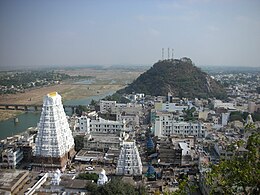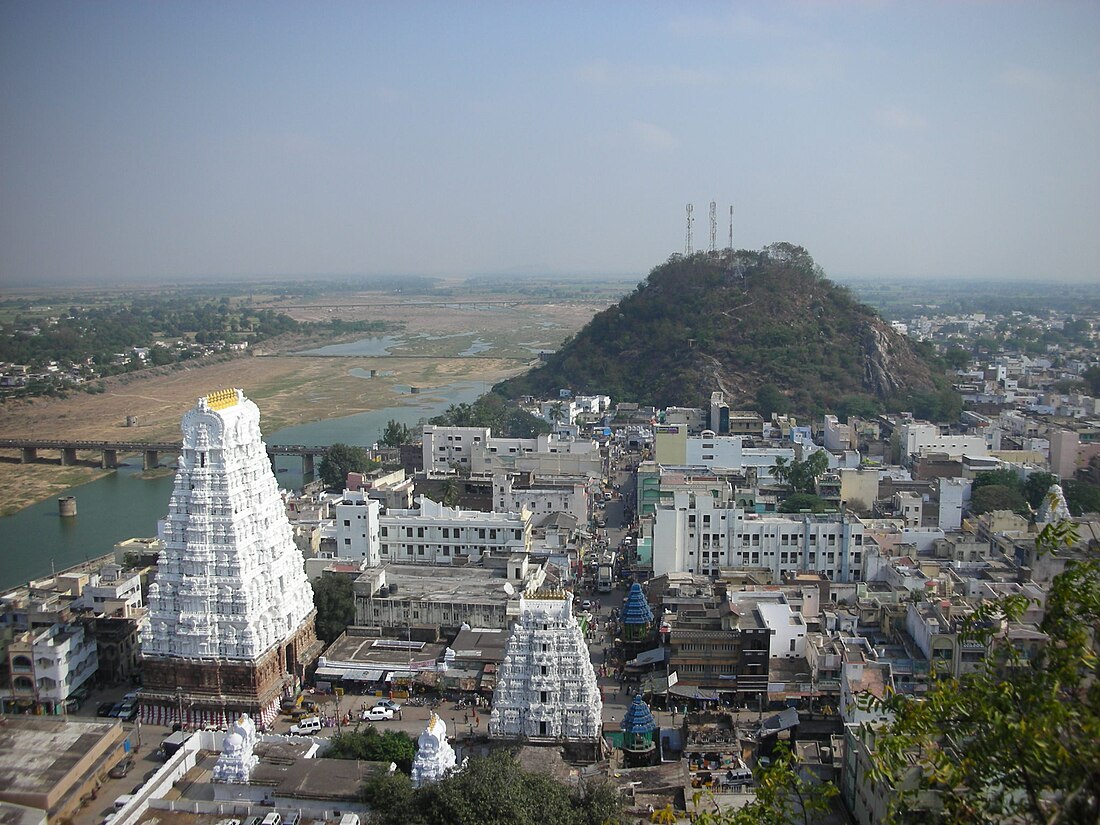Srikalahasteeswara temple
Shiva temple in Tirupati, India From Wikipedia, the free encyclopedia
The Srikalahasti Temple is located in the town of Srikalahasti, in Tirupati district in the state of Andhra Pradesh, India. Shiva in his aspect as Vayu is worshipped as Kalahasteeswara. The temple is also regarded as Rahu-Ketu kshetra and Dakshina Kailasam. According to regional tradition, it is said to be the site where Kannappa was ready to offer both his eyes to cover blood flowing from the Shivalinga before Shiva stopped him and granted him moksha.[3]
| Sri Gnanaprasunambika sametha Srikalahasteeswara Temple శ్రీ జ్ఞాన ప్రసూనాంబికా సమేత శ్రీ కాళ హస్తిశ్వర ఆలయం | |
|---|---|
 An aerial view of the town and the temple | |
| Religion | |
| Affiliation | Hinduism |
| District | Tirupati |
| Deity | Srikalahasteeswara (Shiva), Gnana Prasunambika Devi[1] (Parvati) |
| Festivals | Maha Sivaratri |
| Location | |
| Location | Srikalahasti |
| State | Andhra Pradesh |
| Country | India |
| Geographic coordinates | 13°44′58″N 79°41′54″E |
| Architecture | |
| Type | Dravidian architecture[2] |
| Creator | Rajendra Chola I |
| Date established | 5th century CE |
| Website | |
| Srikalahasti | |
Srikalahasti temple, situated 36 km away from Tirupati, is famous for its Vayu Lingam (Wind Lingam), one of the Pancha Bhuta Sthalams, representing the wind.
Legend
Summarize
Perspective
In primordial times, the wind-god Vayu performed penance for thousands of years to the Karpoora Lingam, the lingam of Shiva made of camphor. Pleased with Vayu's penance, Shiva manifested before him and bestowed him three boons. Vayu was blessed to present everywhere in the world in form of air and want to be an integral part of every being in form of vayus. Further, The linga that Vayu worshipped was named as the Vayu Lingam after him and was declared to be worshipped by various beings.[4]
Another legend narrates that Shiva's consort Parvati adamantly asked him to teach her the secret of the Shiva Panchakshari Mantra. Angry with her behaviour, Shiva cursed her to discard her divine form and assume a human form. Parvati fell to the Earth. To atone, Parvati performed penance at Srikalahasti and pleased Shiva. Shiva granted her a heavenly body, a hundred times better than her previous divine form, apologised to her and later taught her the secret lore. Parvati is therefore worshipped as Gnana Prasunambika Devi in the temple.
Cursed to become a ghost, Ghanakala prayed at Srikalahasti for 15 years and after chanting the Bhairava Mantra, Shiva restored her original form.
Mayura, Chandra and Indra were cursed to become a spider, snake and elephant respectively. They sought atonement after taking bath in the river Swarnamukhi and praying at Srikalahasti.
Shiva appeared before the sage Markandeya in Srikalahasti and preached that a Guru alone could make esoteric teachings and, therefore he is Brahma, Vishnu and Shiva.
History
Summarize
Perspective

Around the 11th century CE, the Chola emperor Rajendra Chola I king renovated the temple and constructed the main structure.[5] Kulottunga Chola I, contrived and built the beautiful gopurams, located at the entrance facing south, during the 11th century CE. Inscriptions of Rajaditya Chola, Rajaraja Chola I, Rajadhiraja Chola I, Kulottunga Chola I, Kulottunga Chola III are found across the temple. The temple received contributions from various ruling dynasties like Chola Dynasty, Reddi kingdom and Vijayanagar Empire. The 120 feet (37 m) high main gopuram and the hundred pillared hall with intricate carvings was commissioned during the regime of the Vijayanagara Krishnadevaraya during 1516 CE.[6]
The main gopuram, built by king Krishnadevaraya, collapsed on 26 May 2010.[7][8] As per the Archaeology Department, the temple tower stood on a foundation that had a depth of only one-and-a-half feet and had a thin crack 25 years before it collapsed which expanded as years passed by.[9][10] The Rajagopuram was reconstructed in its original form at the same location with a budget of 45 crores and was consecrated on 18 January 2017.[7]
Architecture
Summarize
Perspective

The presiding image of Shiva in the form of Linga is made of white stone (believed to be the solidification of camphor) in a tall cylindrical shape resembling an elephant trunk. The stone is divided into 5 segments. The lingam is lit by many lamps in the sanctum. Miraculously, the lingam never caught fire even though camphor is a flammable substance. The temple faces south, while the sanctum faces west. The temple is located on the foothills of a hill, while there is also a belief that the temple was carved out of the monolithic hill. There is a rock-cut shrine of Shiva's son Ganesha, 9 ft (2.7 m) below the ground level. Vallabha Ganapathi, Mahalakshmi-Ganpathi and Sahasra Lingeswara are some of the rare images found in the temple. There is a large shrine of Jnanaprasunambika, the consort of Kalahatisvara. There are smaller shrines in the temple for Kasi Viswanatha, Annapurna, Surya, Sadyoganapathi and Shiva's second son Kartikeya. There are two large halls namely Sadyogi Mandapa and Jalkoti Mandapa. There are two water tanks associated with the temple namely, Surya Pushkarani and Chandra Pushkarani.[6]
Religious importance
Summarize
Perspective

The temple is revered as one of the Pancha Bhoota Stalam where the presiding deity is worshipped as Vayu linga (the embodiment of air). This temple is considered the "Kailash of the South".[11] Saivaite saints of the first century sang about this temple. This is the only temple in India which remains open during Solar and lunar eclipses, while, all other temples are closed.[12] This temple is famous for the Rahu-Kethu pooja. It is believed that performing this pooja will ward the people from astrological effects of Rahu and Kethu, the demigods which cause eclipses.[12]
As per Hindu legend, Kalahasteeshwara was worshipped at this place by Brahma during all four Yugas. Arjuna, the Pandava prince during Mahabharata is believed to have worshipped the presiding deity. The legend of Kannappa, who was a hunter and turned into an ardent devotee of Shiva accidentally, is associated with the temple.
The temple also finds mention in the works of Nakeerar and the Nalvars, namely, Appar, Sundarar, Sambandar and Manickavasagar in the canonical works of Tirumura.[6] As the temple is revered in Tevaram, it is classified as Paadal Petra Sthalam, one of the 275 temples that find mention in the Saiva canon.[13]
Culture
The temple follows the Shaivite tradition.[citation needed] Maha Shivaratri is the most important festival when lakhs of devotees offer prayers to seek the blessings of the Lord. Mahashivaratri Brahmotsavams are celebrated in par with Maha Shivaratri for 13 days during which the processional idols of Shiva and Parvati will be taken on Vahanams in a procession around the temple streets.[14]
References
External links
Wikiwand - on
Seamless Wikipedia browsing. On steroids.

